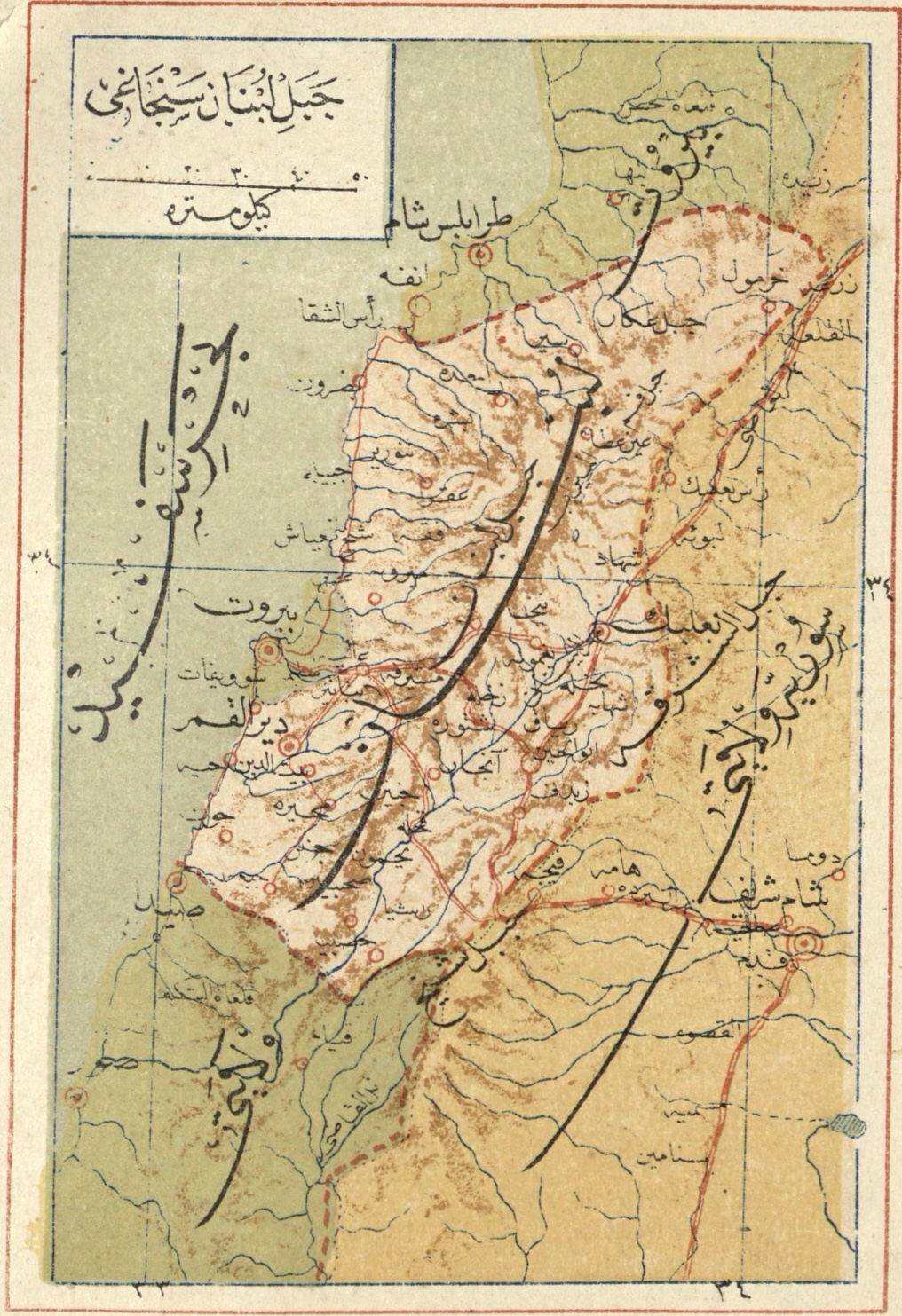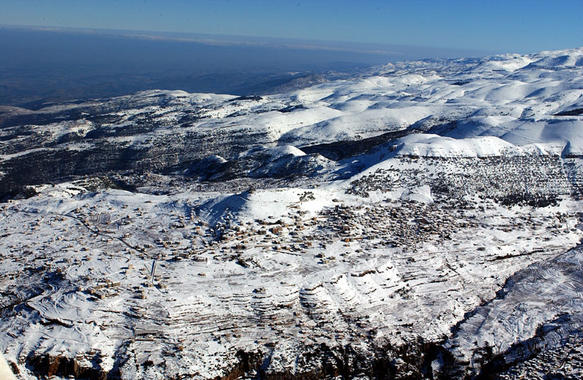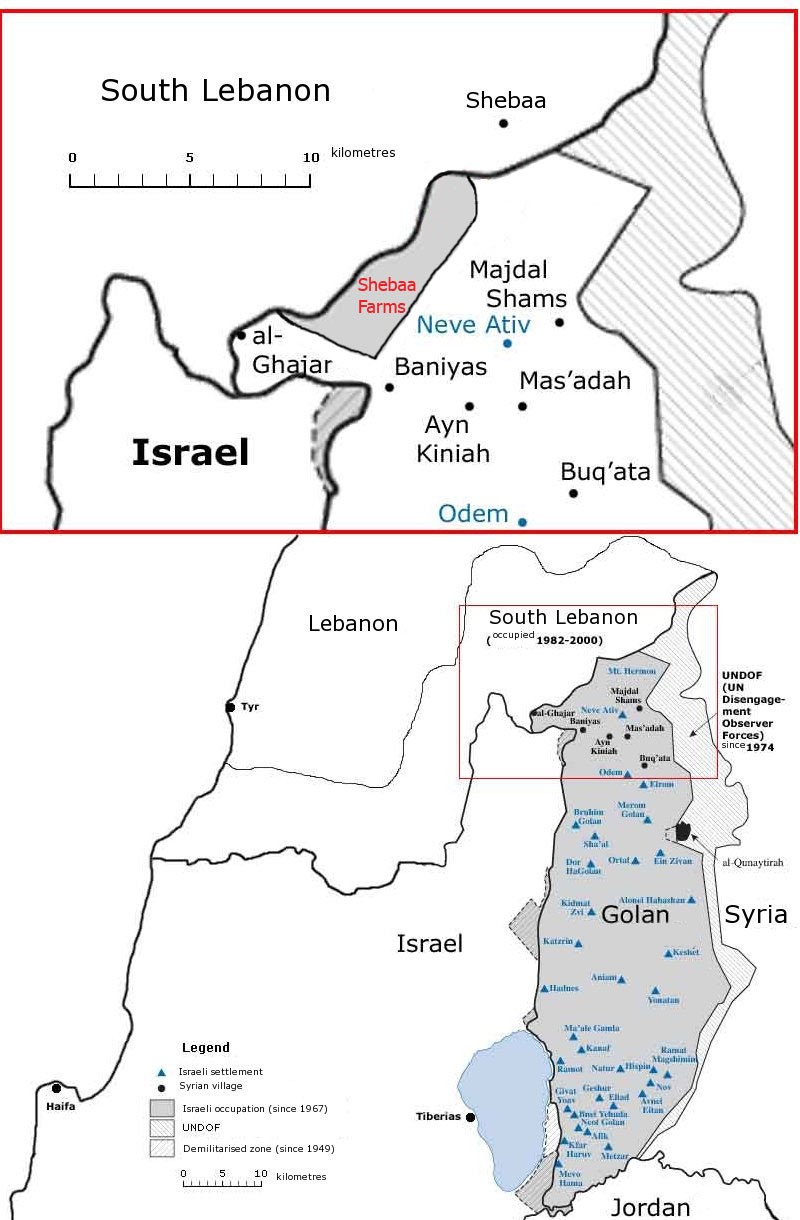|
Lebanon–Syria Border
The Lebanon–Syria border is 394 km (245 miles) in length and runs from the Mediterranean coast in the north to the tripoint with Israel in the south. Description The border starts at confluence of the Nahr al-Kabir river with the Mediterranean Sea, and then follows this river eastwards some distance inland. The Lebanese border forms a Salient (geography), salient to include the villages of Karha and Knaisse Akkar in the north-east of Akkar District, just west of the Syrian Lake Homs, before turning to the south-east via a series of irregular lines, cutting across the Orontes River, Orontes (at ) and the Beqaa Valley, trans-Beqaa road between Qaa and Al-Qusayr, Syria, Al-Qusayr (at ), reaching the Anti-Lebanon Mountains at about . The border then turns towards the south-west, generally following the Anti-Lebanon Mountains via a series of irregular lines, until reaching Mount Hermon. The precise location of the Lebanese–Israeli–Syrian tripoint is unclear due to Israel's o ... [...More Info...] [...Related Items...] OR: [Wikipedia] [Google] [Baidu] |
Lebanon Physiography
Lebanon, officially the Republic of Lebanon, is a country in the Levant region of West Asia. Situated at the crossroads of the Mediterranean Basin and the Arabian Peninsula, it is bordered by Syria to the north and east, Israel to the south, and the Mediterranean Sea to the west; Cyprus lies a short distance from the coastline. Lebanon has a population of more than five million and an area of . Beirut is the country's capital and largest city. Human habitation in Lebanon dates to 5000 BC. From 3200 to 539 BC, it was part of Phoenicia, a maritime civilization that spanned the Mediterranean Basin. In 64 BC, the region became part of the Roman Empire and the subsequent Byzantine Empire. After the seventh century, it Muslim conquest of the Levant, came under the rule of different Islamic caliphates, including the Rashidun Caliphate, Rashidun, Umayyad Caliphate, Umayyad and Abbasid Caliphate, Abbasid. The 11th century saw the establishment of Christian Crusader states, which fell ... [...More Info...] [...Related Items...] OR: [Wikipedia] [Google] [Baidu] |
Hasbani River
The Hasbani ( / ALA-LC: ''al-Ḥāṣbānī''; ''Ḥatzbaní'') or Snir Stream ( / ''Nahal Sənir''), is the major tributary of the Jordan River that flows in Lebanon, the Golan Heights and Israel. In the mid-19th century, what the Westerners would call 'Upper Jordan River', the locals called Nahr Hasbani, Arabic for Hasbani River. The Hasbani River derives most of its discharge from two springs in Lebanon, the Wazzani and the Haqzbieh, the latter being a group of springs on the uppermost Hasbani. The Hasbani runs for through the Wadi al-Taym in Lebanon before crossing the border at Ghajar and shortly after joining with the Banias and Dan Rivers at a point in northern Israel, to form the River Jordan. For about downstream of Ghajar, the Hasbani forms the border between Lebanon and the Golan Heights. The Wazzani's and the Haqzbieh's combined discharge averages 138 million m³ per year. About 20% of the Hasbani flow emerges from the Wazzani Spring at Ghajar, close to t ... [...More Info...] [...Related Items...] OR: [Wikipedia] [Google] [Baidu] |
Greater Lebanon
The State of Greater Lebanon (; ), informally known as French Lebanon, was a state declared on 1 September 1920, which became the Lebanese Republic (; ) in May 1926, and is the predecessor of modern Lebanon. The state was declared on 1 September 1920, following Decree 318 of 31 August 1920, as a League of Nations Mandate under the proposed terms of the Mandate for Syria and the Lebanon which was to be ratified in 1923. When the Ottoman Empire was formally split up by the Treaty of Sèvres in 1920, it was decided that four of its territories in the Middle East should be League of Nations mandates temporarily governed by the United Kingdom and France on behalf of the League. The British were given British Mandate for Palestine (legal instrument), Palestine and British Mandate of Iraq, Iraq, while the French were given a mandate over Syria and Lebanon. Henri Gouraud (general), General Gouraud proclaimed the establishment of the state with its present boundaries after support from t ... [...More Info...] [...Related Items...] OR: [Wikipedia] [Google] [Baidu] |
French Mandate For Syria And The Lebanon
The Mandate for Syria and the Lebanon (; , also referred to as the Levant States; 1923−1946) was a League of Nations mandate founded in the aftermath of the First World War and the partitioning of the Ottoman Empire, concerning the territories of Syria and Lebanon. The mandate system was supposed to differ from colonialism, with the governing country intended to act as a trustee until the inhabitants were considered eligible for self-government. At that point, the mandate would terminate and a sovereign state would be born. During the two years that followed the end of the war in 1918—and in accordance with the Sykes–Picot Agreement signed by the United Kingdom and France during the war—the British held control of most of Ottoman Iraq (now Iraq) and the southern part of Ottoman Syria (now Israel, Palestine and Transjordan), while the French controlled the rest of Ottoman Syria (including Lebanon, Alexandretta, and portions of Cilicia). In the early 1920s, British ... [...More Info...] [...Related Items...] OR: [Wikipedia] [Google] [Baidu] |
Arab Revolt
The Arab Revolt ( ), also known as the Great Arab Revolt ( ), was an armed uprising by the Hashemite-led Arabs of the Hejaz against the Ottoman Empire amidst the Middle Eastern theatre of World War I. On the basis of the McMahon–Hussein Correspondence, exchanged between Henry McMahon of the United Kingdom and Hussein bin Ali of the Kingdom of Hejaz, the rebellion against the ruling Turks was officially initiated at Mecca on 10 June 1916. The primary goal of the Arab rebels was to establish an independent and unified Arab state stretching from Aleppo to Aden, which the British government had promised to recognize. The Sharifian Army, led by Hussein and the Hashemites with backing from the British military's Egyptian Expeditionary Force, successfully fought and expelled the Ottoman military presence from much of the Hejaz and Transjordan. By 1918, the rebels had captured Damascus and proclaimed the Arab Kingdom of Syria, a short-lived monarchy that was led by Hussein ... [...More Info...] [...Related Items...] OR: [Wikipedia] [Google] [Baidu] |
First World War
World War I or the First World War (28 July 1914 – 11 November 1918), also known as the Great War, was a World war, global conflict between two coalitions: the Allies of World War I, Allies (or Entente) and the Central Powers. Fighting took place mainly in European theatre of World War I, Europe and the Middle Eastern theatre of World War I, Middle East, as well as in parts of African theatre of World War I, Africa and the Asian and Pacific theatre of World War I, Asia-Pacific, and in Europe was characterised by trench warfare; the widespread use of Artillery of World War I, artillery, machine guns, and Chemical weapons in World War I, chemical weapons (gas); and the introductions of Tanks in World War I, tanks and Aviation in World War I, aircraft. World War I was one of the List of wars by death toll, deadliest conflicts in history, resulting in an estimated World War I casualties, 10 million military dead and more than 20 million wounded, plus some 10 million civilian de ... [...More Info...] [...Related Items...] OR: [Wikipedia] [Google] [Baidu] |
Mount Lebanon Mutasarrifate
The Mount Lebanon Mutasarrifate (1861–1918, ; ) was one of the Ottoman Empire's subdivisions following the 19th-century Tanzimat reform. After 1861, there existed an autonomous Mount Lebanon with a Christian Mutasarrif (governor), which had been created as a homeland for the Maronites under European diplomatic pressure following the 1860 Druze–Maronite conflict. The Maronite Catholics and the Druze founded modern Lebanon in the early eighteenth century, through the ruling and social system known as the "Maronite-Druze dualism" in Mount Lebanon. This system came during the era of Tanzimat reforms initiated by Sultan Abdulmejid I in an attempt to extricate the Ottoman State from its internal problems, and it was approved after the major sectarian strife of 1860 and the numerous massacres that occurred in Mount Lebanon, Damascus, the Beqaa Valley and Jabal Amil among Muslims and Christians in general, and the Druze and Maronites in particular; the European countries exploited th ... [...More Info...] [...Related Items...] OR: [Wikipedia] [Google] [Baidu] |
Mount Lebanon
Mount Lebanon (, ; , ; ) is a mountain range in Lebanon. It is about long and averages above in elevation, with its peak at . The range provides a typical alpine climate year-round. Mount Lebanon is well-known for its snow-covered mountains, home to surviving Cedrus libani, Lebanese cedar forests and diverse high-altitude flora and fauna. The name Lebanon itself originates from the white, snow-covered tops of this mountain range. Geography The Mount Lebanon range extends along the entire country for about , parallel to the Mediterranean Sea, Mediterranean coast. The highest peak is Qurnat as Sawda', at . The range receives a substantial amount of precipitation, including snow, which averages around in depth.Jin and Krothe. ''Hydrogeology: Proceedings of the 30th International Geological Congress'', p. 170 Lebanon has historically been defined by the mountains, which provided protection for the local population. In Lebanon, changes in scenery are related less to geographical ... [...More Info...] [...Related Items...] OR: [Wikipedia] [Google] [Baidu] |
Ottoman Empire
The Ottoman Empire (), also called the Turkish Empire, was an empire, imperial realm that controlled much of Southeast Europe, West Asia, and North Africa from the 14th to early 20th centuries; it also controlled parts of southeastern Central Europe, between the early 16th and early 18th centuries. The empire emerged from a Anatolian beyliks, ''beylik'', or principality, founded in northwestern Anatolia in by the Turkoman (ethnonym), Turkoman tribal leader Osman I. His successors Ottoman wars in Europe, conquered much of Anatolia and expanded into the Balkans by the mid-14th century, transforming their petty kingdom into a transcontinental empire. The Ottomans ended the Byzantine Empire with the Fall of Constantinople, conquest of Constantinople in 1453 by Mehmed II. With its capital at History of Istanbul#Ottoman Empire, Constantinople (modern-day Istanbul) and control over a significant portion of the Mediterranean Basin, the Ottoman Empire was at the centre of interacti ... [...More Info...] [...Related Items...] OR: [Wikipedia] [Google] [Baidu] |
French Mandate For Syria And The Lebanon Map En
French may refer to: * Something of, from, or related to France ** French language, which originated in France ** French people, a nation and ethnic group ** French cuisine, cooking traditions and practices Arts and media * The French (band), a British rock band * "French" (episode), a live-action episode of ''The Super Mario Bros. Super Show!'' * ''Française'' (film), a 2008 film * French Stewart (born 1964), American actor Other uses * French (surname), a surname (including a list of people with the name) * French (tunic), a type of military jacket or tunic * French's, an American brand of mustard condiment * French (catheter scale), a unit of measurement * French Defence, a chess opening * French kiss, a type of kiss See also * France (other) * Franch, a surname * French Revolution (other) * French River (other), several rivers and other places * Frenching (other) * Justice French (other) Justice French may refer to: * C. ... [...More Info...] [...Related Items...] OR: [Wikipedia] [Google] [Baidu] |
Shebaa Farms
The Shebaa Farms, also spelled Sheba'a Farms (, '; ''Havot Sheba‘a),'' also known as Mount Dov (), is a strip of land on the Lebanese–Syrian border that is currently occupied by Israel. Lebanon claims the Shebaa Farms as its own territory, and Syria agrees with this position. Israel claims it is part of the Golan Heights, Syrian territory that it has occupied since 1967 and effectively annexed in 1981. This dispute plays a significant role in contemporary Israel–Lebanon relations. The territory is named for the farms within it which were historically tended by the inhabitants of the Lebanese town of Shebaa. It is about long and wide. The French Mandate for Syria and the Lebanon administration did not demarcate the border between Lebanon and Syria, nor was this done later by Lebanese and Syrian governments. Documents from the 1920s and 1930s indicate that inhabitants paid taxes to the Lebanese government. From the early 1950s to Israel's occupation of the Golan Hei ... [...More Info...] [...Related Items...] OR: [Wikipedia] [Google] [Baidu] |






